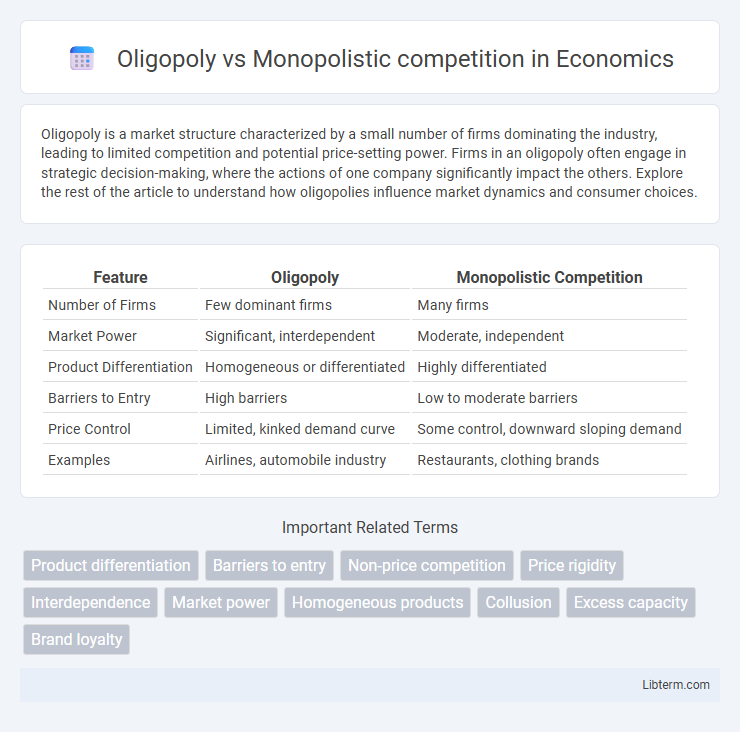Oligopoly is a market structure characterized by a small number of firms dominating the industry, leading to limited competition and potential price-setting power. Firms in an oligopoly often engage in strategic decision-making, where the actions of one company significantly impact the others. Explore the rest of the article to understand how oligopolies influence market dynamics and consumer choices.
Table of Comparison
| Feature | Oligopoly | Monopolistic Competition |
|---|---|---|
| Number of Firms | Few dominant firms | Many firms |
| Market Power | Significant, interdependent | Moderate, independent |
| Product Differentiation | Homogeneous or differentiated | Highly differentiated |
| Barriers to Entry | High barriers | Low to moderate barriers |
| Price Control | Limited, kinked demand curve | Some control, downward sloping demand |
| Examples | Airlines, automobile industry | Restaurants, clothing brands |
Introduction to Market Structures
Oligopoly and monopolistic competition are key market structures distinguished by the number of firms and product differentiation. Oligopoly features a few dominant firms with significant market power, leading to interdependent pricing and strategic behavior. In contrast, monopolistic competition consists of many firms offering differentiated products, resulting in more competitive pricing and greater consumer choice.
Defining Oligopoly
Oligopoly is a market structure characterized by a small number of large firms that dominate the industry, leading to limited competition and high barriers to entry. Firms in an oligopoly often engage in strategic decision-making, where the actions of one firm directly impact the others, resulting in interdependence. This contrasts with monopolistic competition, where many firms compete with differentiated products and relatively low entry barriers.
Defining Monopolistic Competition
Monopolistic competition is a market structure characterized by many firms selling differentiated products, allowing for some degree of pricing power and product variety. Unlike oligopoly, where a few dominant firms control the market, monopolistic competition fosters competition through product differentiation rather than barriers to entry. This results in firms having downward-sloping demand curves, enabling them to influence prices while still facing competition from close substitutes.
Key Characteristics: Oligopoly vs Monopolistic Competition
Oligopoly features a few dominant firms with significant market power, resulting in high barriers to entry and interdependent pricing strategies, whereas monopolistic competition involves many firms with differentiated products and low barriers to entry, leading to independent decision-making. In oligopoly, firms often engage in strategic behavior such as collusion or price leadership, while monopolistic competition is characterized by non-price competition like advertising and product differentiation. Market concentration is higher in oligopoly, creating potential for market control, whereas monopolistic competition leads to more competitive pricing and greater consumer choice.
Pricing Strategies in Both Markets
Oligopoly pricing strategies often involve interdependent decision-making where firms monitor competitors closely, potentially leading to price rigidity or tacit collusion to maintain higher prices. In monopolistic competition, pricing is more flexible due to the presence of many sellers offering differentiated products, allowing firms to use price discrimination or promotional pricing to attract specific consumer segments. Both market structures use strategic pricing, but oligopolies emphasize stability and market share protection, while monopolistic competitors prioritize product differentiation and niche targeting.
Barriers to Entry and Exit
Oligopoly markets exhibit high barriers to entry due to significant capital requirements, economies of scale, and strong brand loyalty, limiting new competitors' ability to enter. In contrast, monopolistic competition features low barriers to entry and exit, allowing firms to easily enter the market with differentiated products and exit without substantial losses. These differences influence market dynamics, pricing power, and long-term profitability in each market structure.
Product Differentiation: Oligopoly vs Monopolistic Competition
Product differentiation in oligopoly markets often involves a few dominant firms that strategically differentiate products to maintain market power and create brand loyalty, leveraging significant advertising and innovation. In monopolistic competition, numerous firms offer a wide variety of slightly differentiated products, allowing consumers to find alternatives easily and ensuring low barriers to entry and exit. The intensity of product differentiation in monopolistic competition leads to greater consumer choice but also results in less pricing power compared to oligopolistic firms.
Market Power and Consumer Impact
Oligopoly markets concentrate market power among a few large firms, enabling them to influence prices and limit consumer choices, often resulting in higher prices and reduced innovation. In monopolistic competition, numerous firms compete with differentiated products, granting consumers more variety and slightly less pricing power for individual firms. Consumer impact differs as oligopolies may lead to less favorable conditions due to collusion or price rigidity, while monopolistic competition tends to encourage innovation and moderate pricing through competitive rivalry.
Real-World Examples
Oligopoly markets like the airline industry in the United States feature a few dominant firms such as American Airlines, Delta, and United controlling most market share, leading to high barriers for new entrants and interdependent pricing strategies. In contrast, monopolistic competition is evident in the restaurant industry where numerous businesses offer differentiated products, such as local dining establishments and fast food chains like McDonald's and Subway, competing primarily on branding and quality. Both market structures demonstrate varying degrees of market power and competition, influencing pricing, product diversity, and consumer choice in real-world economic environments.
Conclusion and Key Takeaways
Oligopoly markets are dominated by a few firms with significant market power, leading to higher barriers to entry and strategic interactions, while monopolistic competition features many firms with differentiated products and relatively low entry barriers, promoting more competition. Pricing in oligopolies tends to be less flexible due to mutual interdependence, whereas firms in monopolistic competition have more freedom to set prices but face more elastic demand. Understanding these differences is crucial for analyzing market behaviors, consumer choices, and regulatory impacts in various industries.
Oligopoly Infographic

 libterm.com
libterm.com